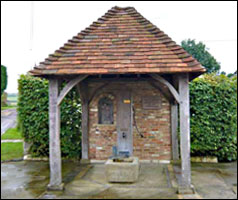![]()
The contents on this page remain on our website for informational purposes only.
Content on this page will not be reviewed or updated.
 |
|
 |
|
|
||
|
North Marston: Schorne Well
|
||
|
||
|
Stuff that. It seems Angela Rippon is advocating a campaign for the over 55s to indulge in more exercise. Well, Ms. Rippon, as one who has spent the best part of 60 years studiously avoiding any forms of unnecessary exertion, I’m certainly passing on that one.
And anyway, I get quite enough recreation already, by regularly taking a half day’s leave from the drudge of daily employment, and, 35mm camera to hand, heading off into the local countryside, to investigate some more fascinating aspects of the surrounding heritage. But of course with the advancing years this has to be done at a leisurely pace, and therefore a pilgrimage is essential en route to one of those quintessential embodiments of rural England, a village tea room. Those in Stewkley and Swanbourne can be highly recommended, and perhaps there were also teashops for pilgrims in medieval times, especially for those travelling to the Holy Well at North Marston. Having been the rector of Monks Risborough, Master John Schorne first came to that village in 1290, and one of his many miraculous deeds was to supposedly ‘conjure the devil into a boot.’ Having been called to ‘exorcise’ an epileptic woman he proceeded to cast out the devil and imprison him in a boot, and thereafter the superstitious villagers were quite happy to believe that she was no longer possessed. Indeed, this incident is thought to have been the origin of the Jack in the Box, and news of John’s miraculous ability soon lead to his widespread renown. In fact in further emphasis of his remarkable powers, when during a severe drought he tapped the ground with his staff a spring bubbled forth, and the resulting well gained such a repute for its curative properties, being especially ‘moch sowght for the agow,’ that multitudes of medieval pilgrims came to visit the village. Their offerings soon enabled the parish church to be much enhanced, both architecturally and decoratively, and quite possibly those half timbered dwellings in Church Street were built as guest housing. Indeed, having been probably lost by one of the pilgrims a tiny pewter badge, depicting Sir John holding the boot (in which he imprisoned the devil) is to be seen in the County Museum at Aylesbury. As decreed by his will, Sir John Schorne was buried in 1314 in the north chancel of North Marston church (where his ‘knees became horny’ through so much prayer) but his legend travelled far beyond the confines of North Marston since, due to the many miracles that were said to occur at his tomb, it became a revered shrine for pilgrims. Jealous of this increasing fame, in 1478 the Bishop of Salisbury then obtained a licence from the Pope to have the shrine moved to the rebuilt St. Georges Chapel, Windsor to be placed in John Schorne’s Tower. Nevertheless, North Marston still had the Holy Well (sometimes known as the Town Well) and for centuries physicians from Winslow and Aylesbury would include the water in their medicines. Those seeking a watery benefit drank from a chained gold cup, and - perhaps in evidence of the remarkable properties - although in 1835 several villages in the neighbourhood suffered from a cholera epidemic, North Marston escaped without a single fatality. Yet despite the magical properties of this concoction they proved insufficient to save Jane Watson, who tragically slipped into the well and drowned one morning in July 1861. Her 3 year old daughter, Sarah, rushed for help, but nothing could be done. After this the authorities declared the well unsafe, and a wall to enclose the original basin was built. A hinged trap door partly covered the depths, but even until the 1930s the well remained a principal source of water for the village, drawn by a pump. In an extensive project in 2004/2005 a complete remodelling then took place. Ideal perhaps for a cycle ride. |
||
|
|
||
|
|
||

